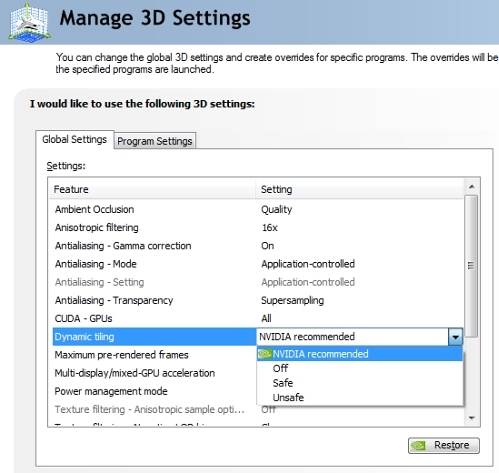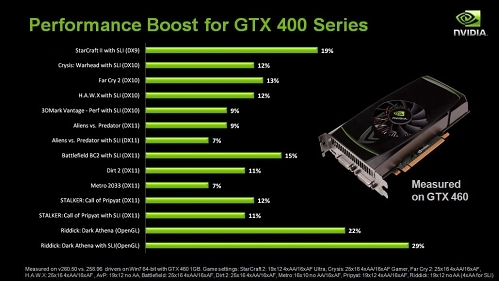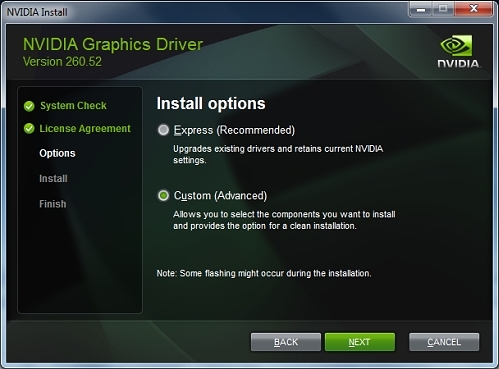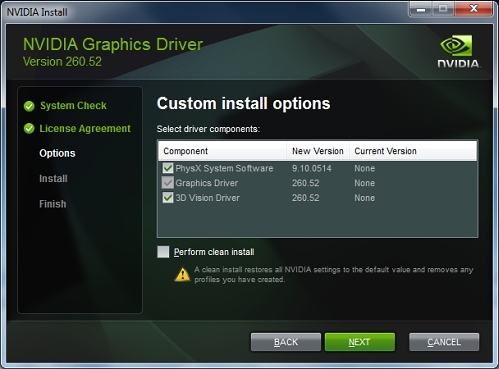As we mentioned last week, sources within Taiwan had managed to leak an internal Geforce 260 Family beta driver release, providing hardware enthusiasts with insight into a variety of new installation mechanics and a new Dynamic Tiling mechanism aimed towards Geforce 400 Series graphics cards. Nevertheless, Geforce 260.62 Beta (8.17.12.6063) drivers are dated Friday, September 10, 2010 and include the same PhysX 9.10.0514 software update found in the 260.52 leaked driver release.

New Dynamic Tiling feature found in Geforce 260 Driver Family
Nvidia is emphasizing performance optimizations for Geforce 400 Series owners, as this driver release comes just six weeks after the launch of the company's highly successful Geforce GTX 460 midrange card. For Geforce GTX 460 owners, the latest driver release promises an abundance of gameplay improvements, with up to 19 percent in StarCraft II (SLI – 1920x1200 4xAA/16xAF Ultra), up to 15 percent in Battlefield Bad Company 2 (SLI – 2560x1600 4xAA/16xAF), up to 12 percent in S.T.A.L.K.E.R.: Call of Pripyat (2560x1600 noAA), up to 12 percent in Crysis Warhead (SLI – 1920x1200 4xAA/16xAF Gamer) and up to 5 percent in 3DMark Vantage (Extreme Preset) just to name a few.
For Geforce GTX 480 owners, the latest driver releases promises up to 10 percent in StarCraft II (2560x1600 4xAA/16xAF Ultra), up to 14 percent in S.T.A.L.K.E.R.: Call of Pripyat (single-card 1920x1200 4xAA/16xAF), up to 16 percent in S.T.A.L.K.E.R.: Call of Pripyat (SLI – 2560x1600 4xAA/16xAF) and up to 6 percent in Aliens vs. Predator (SLI – 1920x1200 noAA – Tessellation enabled).
Performance comparisons were tested between an internal Geforce 260.50 driver release and the previous Geforce 258.96 WHQL drivers from July 19, 2010.

Geforce 260.62 driver improvements for GTX 400 Series. Larger image here.
As we mentioned on Friday, the new Geforce 260 Driver Family installation package marks a departure from the rather unified installation process Nvidia has implemented over the past few years. Users now have the freedom to perform an Express Install, where GPU drivers are updated while current Nvidia settings are retained, or a Custom (Advanced) Install, which allows custom installation options for discreet driver components. Nvidia has finally managed to implement the installation flexibility that AMD Catalyst users have known for so many years, as the company now allows users to uncheck the installation of PhysX System Software, the 3D Vision Driver, and the Graphics Driver individually.
From Nvidia's driver development team:
For over a year now, our installer team has been working on a complete redesign of the driver install experience and, with Release 260, we are excited to roll out the first phase of that redesign. Users will have the choice of a one-click express installation or a custom installation with new advanced capability. Specifically, the custom install options allow users to choose which driver components to install, including PhysX, 3D Vision and more. Also, for the advanced users that prefer to uninstall their older driver first, or rely on 3rd party driver cleaner software to completely remove older drivers, NVIDIA Install offers the choice of a clean install. During the clean install process, your older driver is completely removed from your system before seamlessly installing the new driver. Users will also notice that NVIDIA Install is faster, especially in the case of systems with multiple GPUs.


Beginning with this beta release, the new Geforce 260 Driver Family also adds support for the recently launched Geforce GTS 450 midrange card that scales very well in SLI according to recent hardware reviews. We can only anticipate that successive driver releases in this new family enable further SLI scalability for Nvidia's Fermi-based graphics architecture, as we're sure the company's financial investors are looking to the support of software engineers to ensure that Nvidia has a surviving chance against AMD's upcoming Radeon HD 6000 Series.
Other improvements in the Geforce 260 Driver Family include support for playing back Blu-ray 3D discs when connecting a GPU to an HDMI 1.4 capable 3D TV. Nvidia notes that playback requires compatible software application from CyberLink, ArcSoft, Roxio, or Corel. The new release also adds support for a variety of new HD Audio codecs and upgrades the HD Audio driver to version 1.1.9.0. New features include lossless DTS-HD Master Audio and Dolby TrueHD audio bitstreaming support for compatible Blu-ray movies with Geforce GTX 460 graphics cards. The release also adds high definition 24-bit, 96 and 192 KHz multi-channel audio sampling rate support for compatible Blu-ray movies with Geforce GTX 400 Series, Geforce GT 240, Geforce GT 220 and Geforce 210 graphics cards.
Nvidia has also added a nice assortment of 3D Vision features to accompany the average user's general desktop experience. At the top of the list is the addition of 3D Vision streaming support for Firefox 4 and Google Chrome web browsers. This will allow users to live stream 3D-enabled content over the web in either of these GPU-accelerated browsers with much lower strain on CPU resources in the background. The release also adds support for new 3D Vision desktop LCD monitors - BenQ X2410 and NEC F23W2A - as well as 3D Vision projectors - Sanyo PDG-DWL2500 and ViewSonic PJD6251.
Lastly, the new Geforce 260 Driver Family improves compatibility for older PC games (DirectX 7 to DirectX 9) running on Windows 7. Examples include Gothic, Gothic II, Falcon 4.0: Allied Force, Links 2003, Independence War II - Edge of Chaos, and X2: Wolverine's Revenge. A new drag-and-drop display arrangement has also been added to the “Set up multiple displays” page. Of course, there are also numerous bug fixes addressed within the Geforce 260.62 Beta release, and they can all be found in the release notes.
Geforce 260.62 Beta - Windows 7 / Vista 64-bit (127MB)
Geforce 260.62 Beta - Windows 7 / Vista 32-bit (95.9MB)


